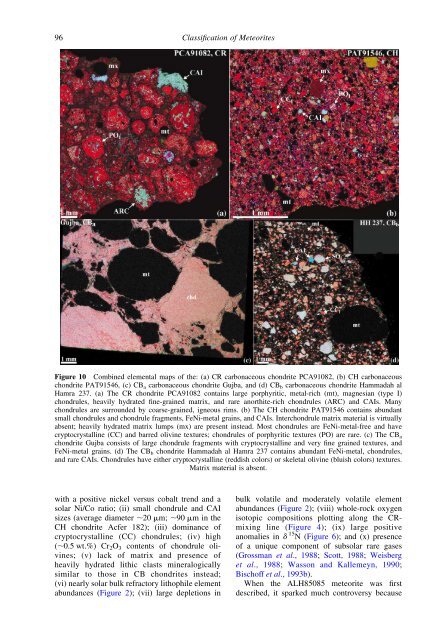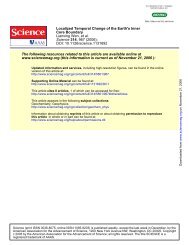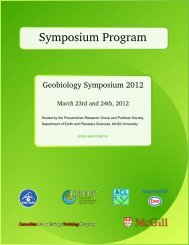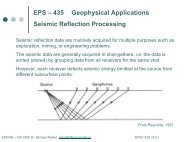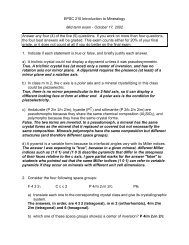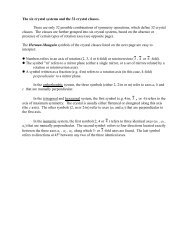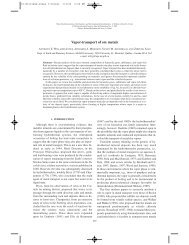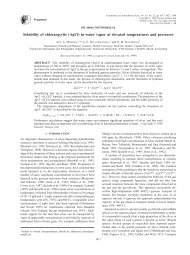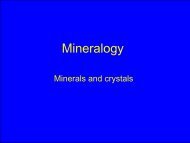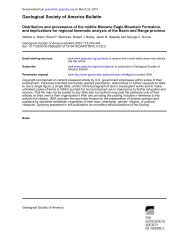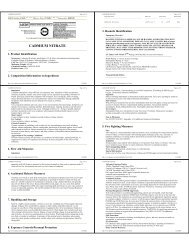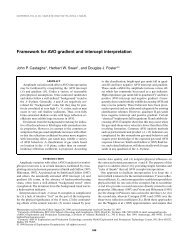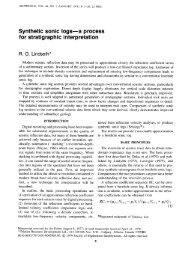05 Classification of.. - Department of Earth and Planetary Sciences
05 Classification of.. - Department of Earth and Planetary Sciences
05 Classification of.. - Department of Earth and Planetary Sciences
Create successful ePaper yourself
Turn your PDF publications into a flip-book with our unique Google optimized e-Paper software.
96<br />
<strong>Classification</strong> <strong>of</strong> Meteorites<br />
Figure 10 Combined elemental maps <strong>of</strong> the: (a) CR carbonaceous chondrite PCA91082, (b) CH carbonaceous<br />
chondrite PAT91546, (c) CB a carbonaceous chondrite Gujba, <strong>and</strong> (d) CB b carbonaceous chondrite Hammadah al<br />
Hamra 237. (a) The CR chondrite PCA91082 contains large porphyritic, metal-rich (mt), magnesian (type I)<br />
chondrules, heavily hydrated fine-grained matrix, <strong>and</strong> rare anorthite-rich chondrules (ARC) <strong>and</strong> CAIs. Many<br />
chondrules are surrounded by coarse-grained, igneous rims. (b) The CH chondrite PAT91546 contains abundant<br />
small chondrules <strong>and</strong> chondrule fragments, FeNi-metal grains, <strong>and</strong> CAIs. Interchondrule matrix material is virtually<br />
absent; heavily hydrated matrix lumps (mx) are present instead. Most chondrules are FeNi-metal-free <strong>and</strong> have<br />
cryptocrystalline (CC) <strong>and</strong> barred olivine textures; chondrules <strong>of</strong> porphyritic textures (PO) are rare. (c) The CB a<br />
chondrite Gujba consists <strong>of</strong> large chondrule fragments with cryptocrystalline <strong>and</strong> very fine grained textures, <strong>and</strong><br />
FeNi-metal grains. (d) The CB b chondrite Hammadah al Hamra 237 contains abundant FeNi-metal, chondrules,<br />
<strong>and</strong> rare CAIs. Chondrules have either cryptocrystalline (reddish colors) or skeletal olivine (bluish colors) textures.<br />
Matrix material is absent.<br />
with a positive nickel versus cobalt trend <strong>and</strong> a<br />
solar Ni/Co ratio; (ii) small chondrule <strong>and</strong> CAI<br />
sizes (average diameter ,20 mm; ,90 mm inthe<br />
CH chondrite Acfer 182); (iii) dominance <strong>of</strong><br />
cryptocrystalline (CC) chondrules; (iv) high<br />
(,0.5 wt.%) Cr 2 O 3 contents <strong>of</strong> chondrule olivines;<br />
(v) lack <strong>of</strong> matrix <strong>and</strong> presence <strong>of</strong><br />
heavily hydrated lithic clasts mineralogically<br />
similar to those in CB chondrites instead;<br />
(vi) nearly solar bulk refractory lithophile element<br />
abundances (Figure 2); (vii) large depletions in<br />
bulk volatile <strong>and</strong> moderately volatile element<br />
abundances (Figure 2); (viii) whole-rock oxygen<br />
isotopic compositions plotting along the CRmixing<br />
line (Figure 4); (ix) large positive<br />
anomalies in d 15 N(Figure 6); <strong>and</strong> (x) presence<br />
<strong>of</strong> a unique component <strong>of</strong> subsolar rare gases<br />
(Grossman et al., 1988; Scott, 1988; Weisberg<br />
et al., 1988; Wasson <strong>and</strong> Kallemeyn, 1990;<br />
Bisch<strong>of</strong>f et al., 1993b).<br />
When the ALH85085 meteorite was first<br />
described, it sparked much controversy because


